Forgotten Wonders of the Digital World: Second Life

Has anyone seen all my chairs? (Photo: Ziki Questi)
What does a three-dimensional version of the Internet look like? That might seem like a trick question: wouldn’t that just be IRL, or perhaps some kind of virtual reality only now being invented? But for millions of people, the 3D internet has been around for over a decade, so long that huge swaths of that world, all built by regular users, have come and gone. It’s called Second Life.
For those not in the know, Second Life (SL) is the largest user-generated digital world ever created. Unlike many MMORPGs such as World of Warcraft, SL users (known as “residents”) are not presented with a specific task, but are instead just plopped into a nearly endless virtual space to do as they please. Residents can buy plots of land, using the game’s virtual currency, the Linden Dollar, which can be exchanged for real dollars, on which they can build whole worlds for public or private use. The game (if it can be called that) allows users to create any structures or images or contraptions they would like, limited only by the user’s skill and imagination. As Don Laabs, Senior Director of Product: Virtual Worlds described it to me, ”As on the Internet, people can self-publish based on their interests and the same thing is true on Second Life.”
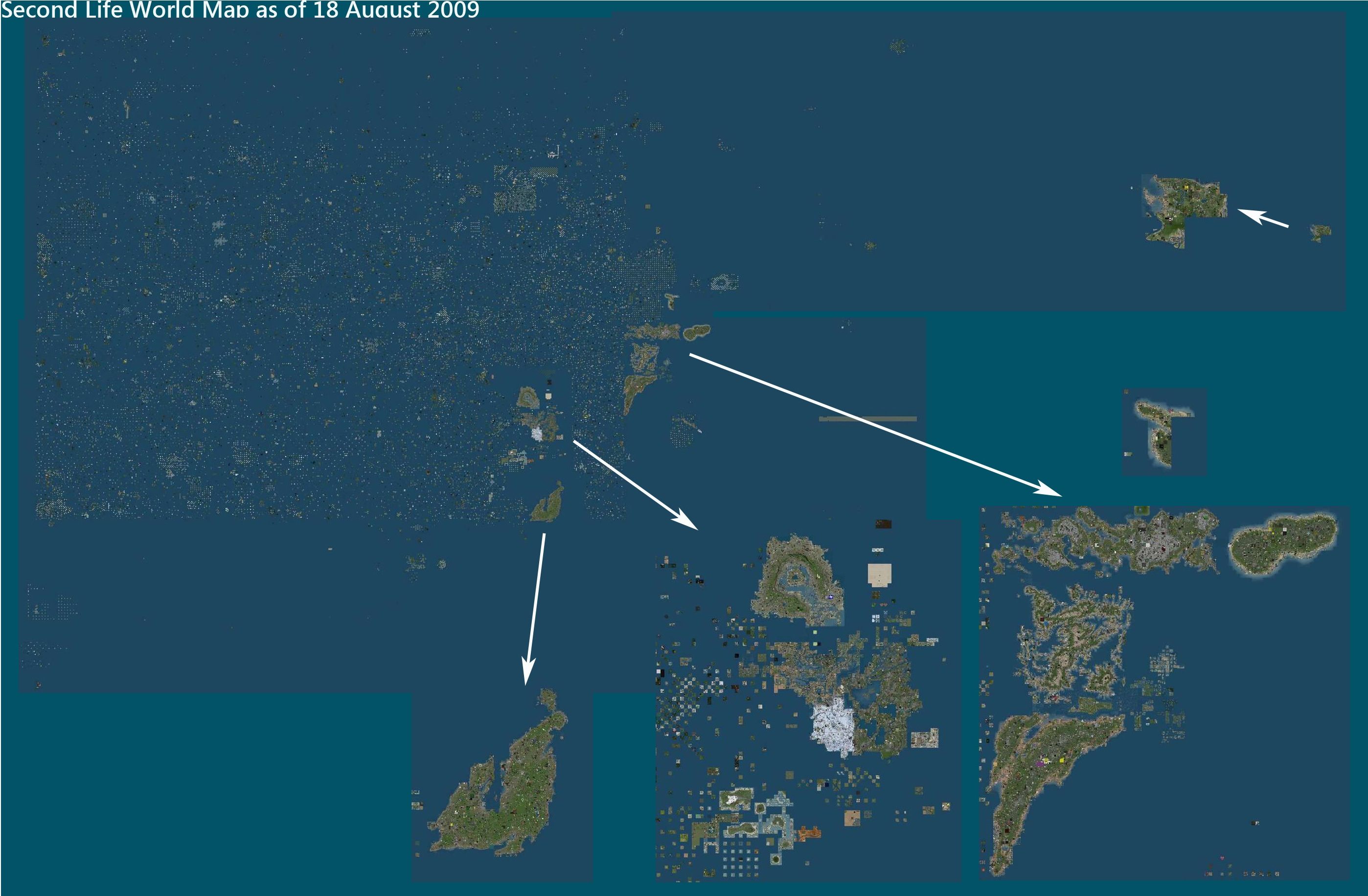
The Grid as of 2009 (Photo: Linden Lab on wiki.secondlife.com)
First launched in 2003 by Linden Lab, Second Life made waves in its early years as the medium that would change the future of how we used the Internet. Futurists saw the open world (known as “The Grid”) as the realization of the all-consuming virtual world from Neal Stephenson’s Snow Crash. An online world where people lived large portions of their lives, building everything from swords and sorcery gaming simulators to sex clubs to abstract artistic spaces. News organizations such as Reuters opened online bureaus and politicians began giving press conferences.
It seemed like the next wave. Until it wasn’t.
Thanks in part to a growing reputation as a haven for trolls looking to assault open regions with Dadaist perversity like flying penises, or as a playground for cybersexual weirdness, not to mention a challenging creation interface that was less-than-friendly to new users, SL fell from the cultural consciousness, with the height of its popularity peaking around the mid-2000s. However, although media attention may have waned, Second Life kept going strong.

A bunch of Second Lifers just enjoying their day. (Photo: HyacintheLuynes on Wikipedia)
Today SL is about to celebrate its 12th anniversary in June, and the world still has around a million active users, which has been a generally steady number for most of the world’s life according to Peter Gray, Senior Director of Global Communications. As I spoke with both Laabs and Gray, who refer to themselves as “Lindens,” which is a surname that employees get in-game, making them instant celebs, they both emphasized the vastness of the world and the variety of its content. When I asked them if there are any trends or themes that seem to sweep the world, they explained that because the world is so reliant on the idiosyncrasies and whims of individual users, the world resists any trends.

Baerf is back. (All images by Eric Grundhauser unless otherwise noted)
Of course, I had to check out the landscape for myself. I logged on to Second Life and chose a nerdy looking pre-made avatar. In SL you have limitless choices as to how you want your character to look, be it a vampire or a drag queen or a dragon, but I tend to get lost during character creation, so I simply chose a non-descript guy with glasses and a backpack. Close enough. After leaving the beginner’s island, I began flying around (you can walk, run, or fly at your leisure if the region allows it). However it was like being dropped in the ocean and asked to catch a specific fish. The map is massive and light on descriptive information.
With almost limitless choices of places to visit in the ever-changing world, I needed a guide. The Lindens pointed me in the direction of one of their longtime users, who goes by the handle, Ziki Questi. Ziki has been using Second Life since 2008 (with this avatar at least). She manages a virtual clothing store in Second Life and makes a fair amount of side money from her online life. She also runs a fascinating blog about various curiosities found in SL. Ziki graciously agreed to be the Virgil to my Dante and take me through some of the wonders of The Grid.

My kindly guides.
We met in-world, in a cube of space that looked like a warm field in early evening. Ziki was there with a friend of hers (Kinn) who wanted to tag along. Both of their avatars were female supermodels who always seemed to be dancing in place. In comparison to my simple pre-fab dork figure, I’ll admit to being a bit self-conscious. The region, was known as The Far Away, was created by a resident named AM Radio, who has been called the “Banksy of Second Life.” The space was simply an open field with random Dust Bowl features spread throughout, such as an abandoned train engine or a lone china hutch next to a dinner set for two. There are hidden features that curious users can find and click on, that will have effects such as sending their avatars flailing into the sky. Ziki tells me that this region has been around since 2007, and is now considered one of the seminal Second Life builds. Given how much turnover there is among the residents, The Far Away is downright historic, but we were the only ones around.

Anyone for a surrealist dinner?
We left the field, and once we walked out of the borders of the zone, I found that we were in the outer, open world of The Grid. It was night in the world, but looking back at where we had come from, it still looked like a dusty Midwestern field in evening. The effect was pretty surreal, like navigating the world using dream logic.
Pressing on, Ziki directly teleported us to our next location, an Asian-inspired warren of city streets that looked like the background from Blade Runner. Known as Kowloon (having been inspired by the real-life walled city), the noirish cityscape also dated back to around 2006, but seemed to serve a wholly different purpose. While The Far Away was more of an artistic statement, Kowloon was built to be interacted with like a role-playing game. The narrow streets and alleys are riddled with little shops where players can buy custom-built textures and items, from little old men whose wares are spread on the ground or hanging from the grimy walls. Some of the computer-controlled characters would even give out quests. Ziki informed me that some residents live in places like this, almost never leaving to explore the rest of The Grid.
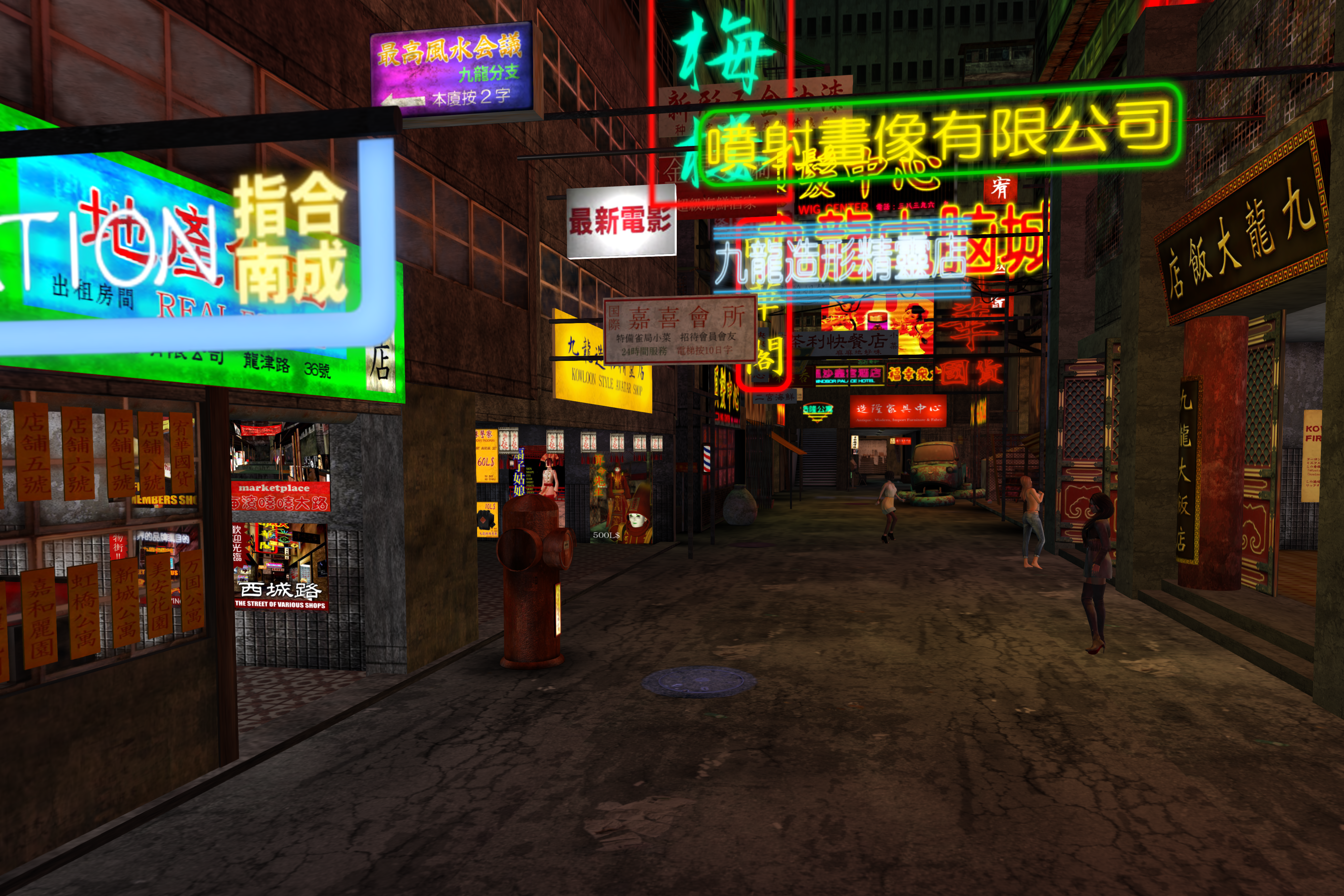
Look out for replicants. (Photo: Ziki Questi)

I don’t know why, but I really liked this old man and that frog.
Next we warped to the most mind-boggling region on our tour, an explorable artwork called City Inside Out, by a resident known as Haveit Neox. This ephemeral creation was built to represent a landscape with no interiors, as a statement on the pains of homelessness. The resulting construction is a realm of impossible spaces where massive abstract shapes float through the sky connected by rickety rope bridges and strands of digital earth. Here and there are architectural flourishes that look like they were imperfectly transported to the region from Italy or ancient Rome, ending up as distorted blobs. The landscape is so strange that finding beautiful little nooks and crannies inspires a very real sense of discovering the unknown. As a 3D work of art, it is only scheduled to remain in place until the end of June, which seemed a shame.

Castles in the sand… (Photo: Ziki Questi)

The information about the artwork is presented in a format that is tough to focus on among the warped chunks of reality.

Terry Gilliam eat your heart out.
From there Ziki, Kinn, and I zipped over to a science-fiction simulator known as Insilico. As Ziki explained to me, this sim was actually a conglomerate of a bunch of regions that were all linked to create one massive, far-future city run by a co-op of residents. As opposed to the dirty alleys of Kowloon, Insilico was all slick skyscrapers and warmly glowing blues and whites. The vistas and areas were wide open and the constant rendering of the colossal skyline made my computer complain. Here we even went inside of one of the large buildings, which had an intricately detailed interior that matched the impressive exterior. Ziki said that there may be hundreds of such fully-rendered buildings in Insilico alone. “Some people LOVE to build.” she says.
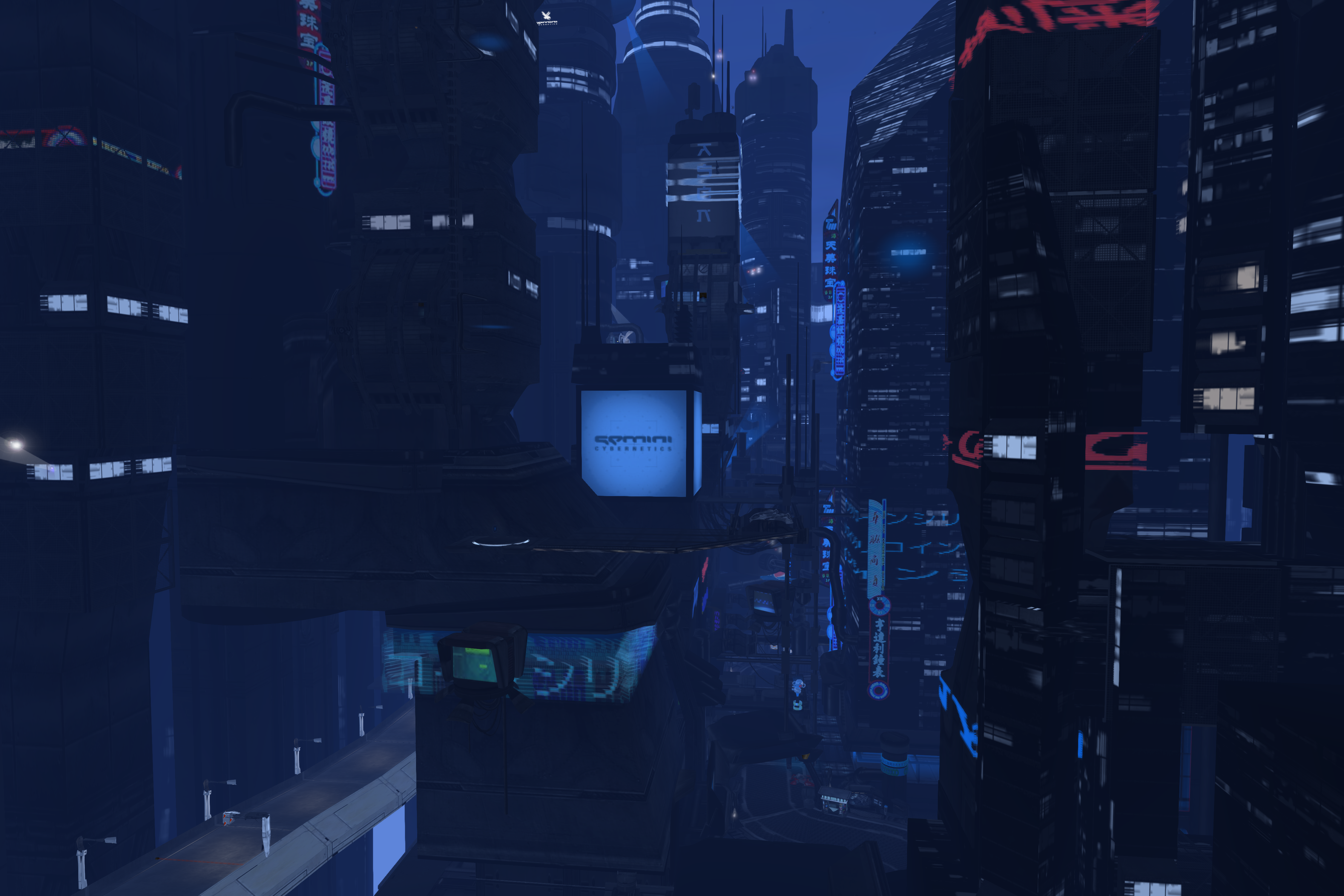
The far future, today! (Photo: Ziki Questi)

The wide-variety of shops available in Insilico.

The interior of a large hotel building in Insilico.
Ziki doesn’t use Second Life for much building, preferring to create avatar clothing and explore the creations of others, but she does retain a small home which she agreed to show me. She has dubbed her zone “…riverrun…,” and it is a private region, so only people who Ziki approves can access it. She warped me to a small cove surrounded by gray mountains on three sides. A pleasant ragtime jazz tune played in the air and the space felt incredibly cozy. The land was sunny and green and dominated by Ziki’s house, a modest, rustic one-story home. Even though we were in a video game, it felt incredibly personal. I had been invited to the special place that Ziki had created to her specification of peace. I didn’t even feel comfortable entering the house until invited. Inside it was tastefully decorated like something out of a West Elm catalogue. What Ziki’s home lacked in the dream-like bombast of some of the rest of Second Life’s crazier locations, it made up for in amazingly personal detail. This was far from the furry-robot-pegasus sex cotillions that are usually assumed to be taking place behind privacy walls (and which, to be fair, probably are). Ziki said that she doesn’t spend much time there, but it is nice to have a homebase.
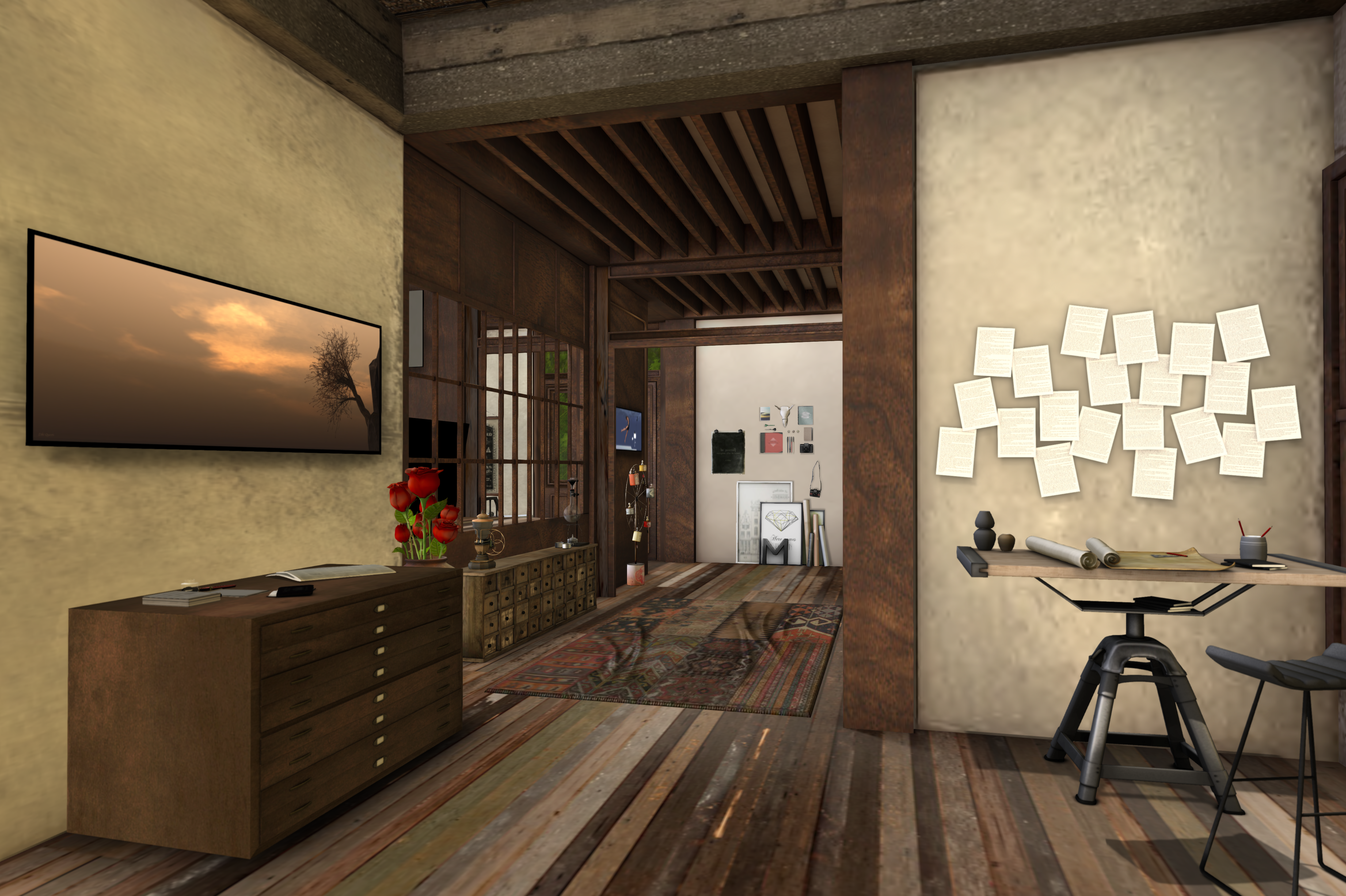
Ziki’s house. (Photo: Ziki Questi)

Some yard art at …riverrun…
Continuing the trend of peaceful creations we next visited the sleepy village of Roche, created by user “ddsm2 mathy.” Ziki informs me that the region was meant to evoke the zen spirit of historic Hokkaido. From my vantage point we seem to be on a rural island dotted with fading gas stations, and old cottages. Again, soothing music plays in the digital air as we walk the dirt paths. Without hyperbole, I can say that I began to feel relaxed. Where some of the regions we visited inspired feelings of adventure and discovery, Roche simply radiated calm. Second Life has, in the past, been used by the military as a tool for therapy and stress reduction, and in the meandering quiet of Roche, it is easy to see why.
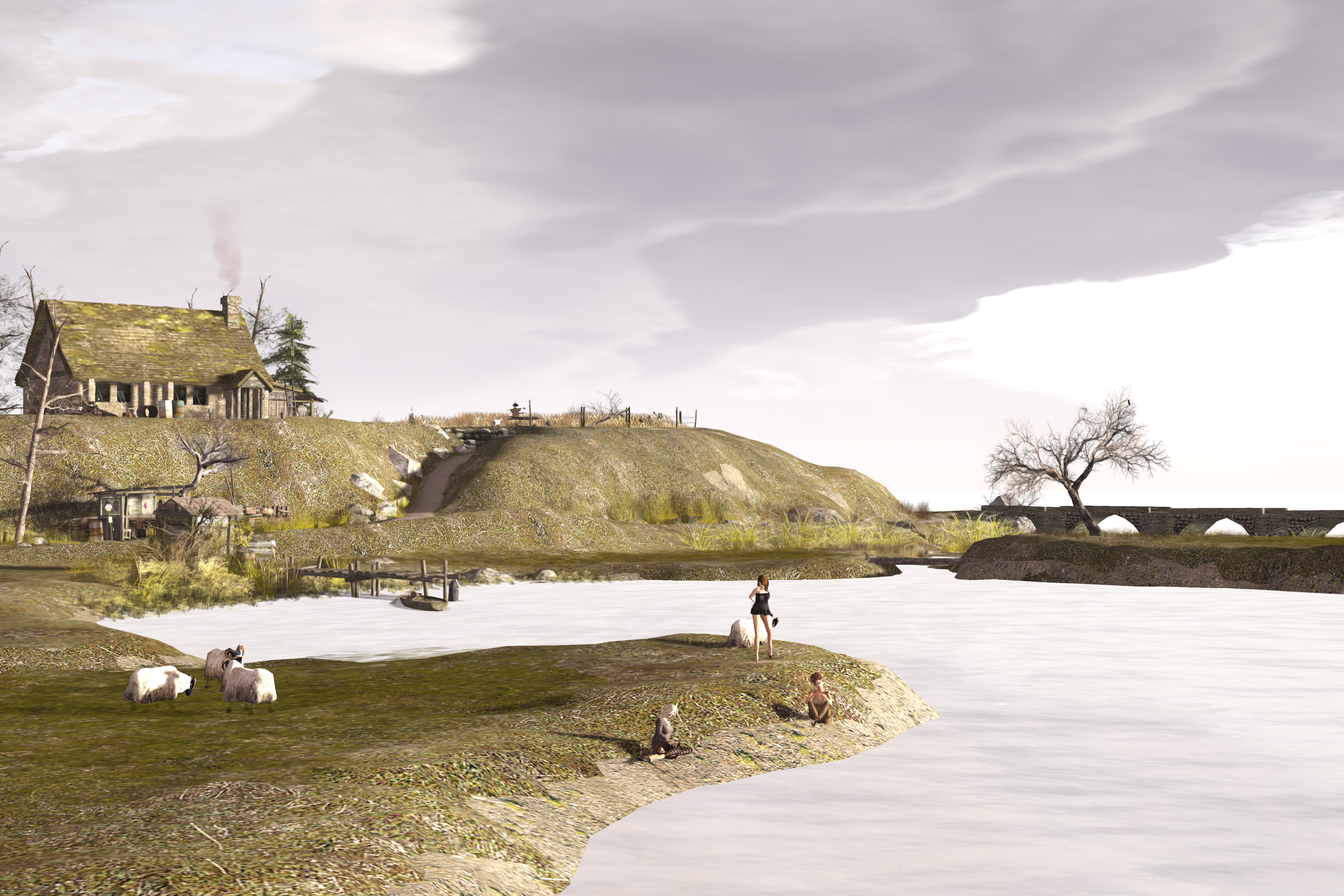
Just another sleepy digital burg. (Photo: Ziki Questi)

A bustop in Roche.

You can make absolutely anything your imagination can conceive of. This resident chose to make a sheep-ish road sign.
There was one last place that Ziki was excited to show me, and with good reason. We finally teleported over to a region known as a Petrovsky Flux. Built by SL artists blotto Epsilon and Cutea Benelli, this ever-evolving piece of art is like a massive tree made of modular rooms that continually grow out from each other until dramatically collapsing under their own weight, just to be randomly regrown once again. Each node looks like a Victorian industrial bathysphere of some kind, and they create twisting tunnels as they reproduce. There are also armchairs that bounce around on springs and odd debris swirling all around giving the space a chaotic feel. Sponsored by the Spencer Museum of Art of the University of Kansas, the region is actually a part of their permanent collection. It simply lives in Second Life.
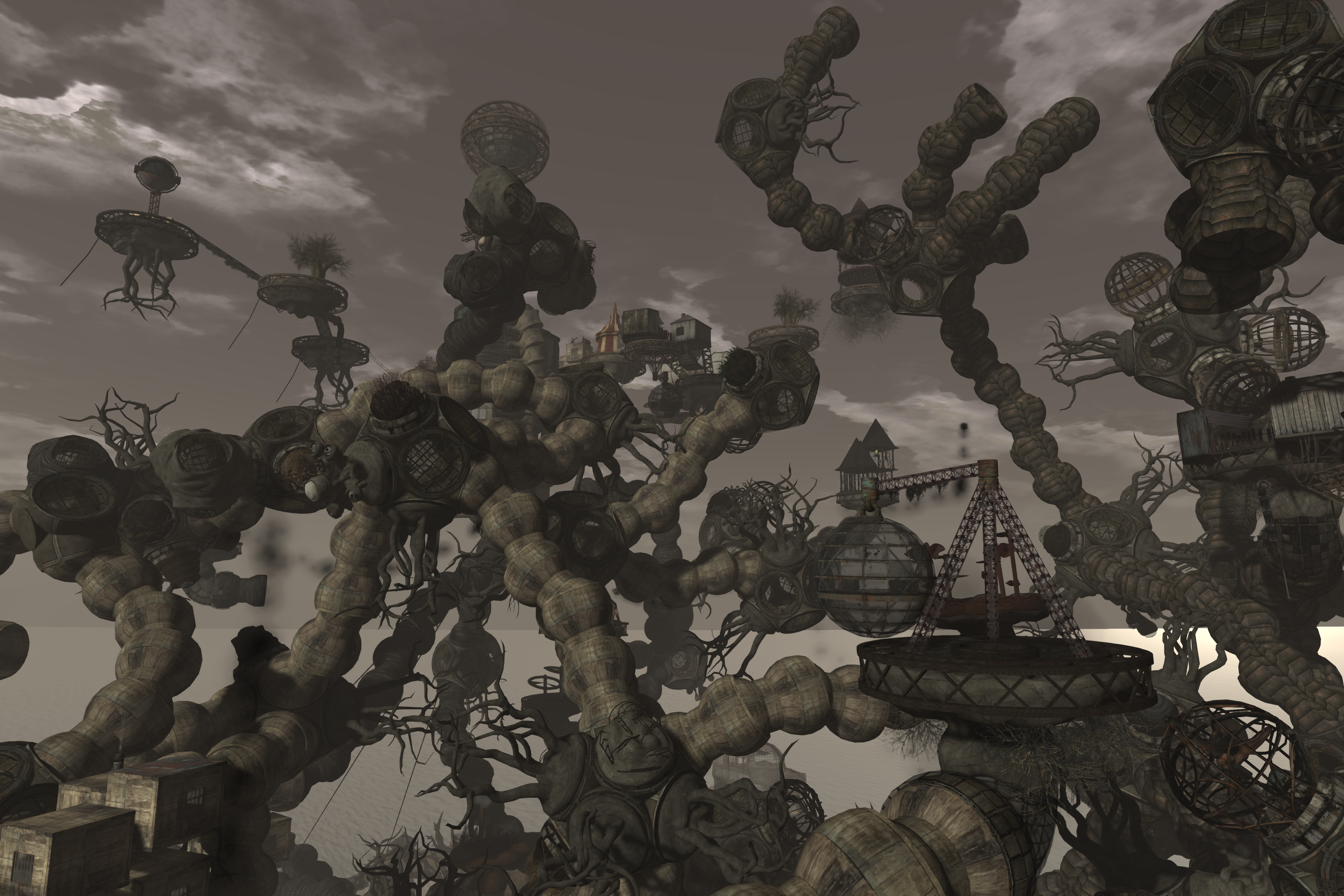
Procedural chaos. (Photo: Ziki Questi)

The oddly apocalyptic a Petrovsky Flux.

In this region the roots grow into the air.

The tree has begun to collapse.
To be honest, when I decided to delve into Second Life, I half-expected to find a dying world of outsiders and bronies gleefully recreating pornographic impossibilities. But that simply doesn’t seem to be true. What I found, and mind you, I was only able to visit a strikingly miniscule portion of the available spaces, was that Second Life is still a fascinating and vital world that is constantly changing and pushing the boundaries of what a virtual space can be. Doctors, universities, hobbyists, sci-fi fans, artists, and inexplicable curiosities can all be found operating in SL, by those willing to look.
Given the constantly changing nature of much of Second Life, it’s hard to say that a location has been forgotten or lost, but during our tours through the various amazing locations, we did not run into more than a handful of other players. It’s possible that the population is diffuse enough to not congregate in too many single areas or that more serious users spend a lot of time in private areas. Wherever they were, they weren’t near us.
More telling I think, is the somewhat widespread perception that Second Life is no longer an active digital playground. The Grid is still a vital and evolving space that hundreds of thousands of users create and evolve each day. And yes, Ziki mentioned that Second Life is a place where “you can certainly explore any sexual fantasy you could imagine.” So while we didn’t see any, there is probably plenty of weird sex stuff too.
Special thanks to Ziki Questi, and Peter Gray and Don Laabs from Linden Lab for helping me navigate the strangeness of Second Life.
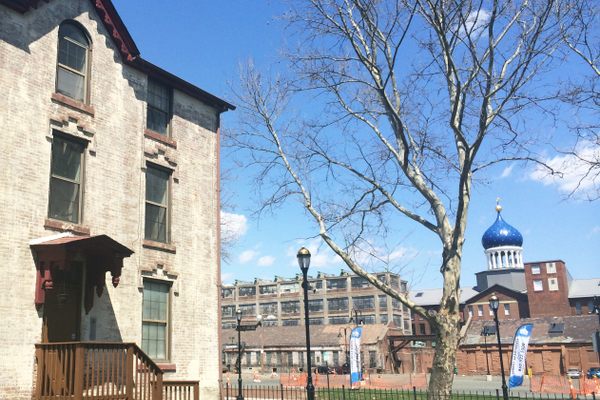








Follow us on Twitter to get the latest on the world's hidden wonders.
Like us on Facebook to get the latest on the world's hidden wonders.
Follow us on Twitter Like us on Facebook